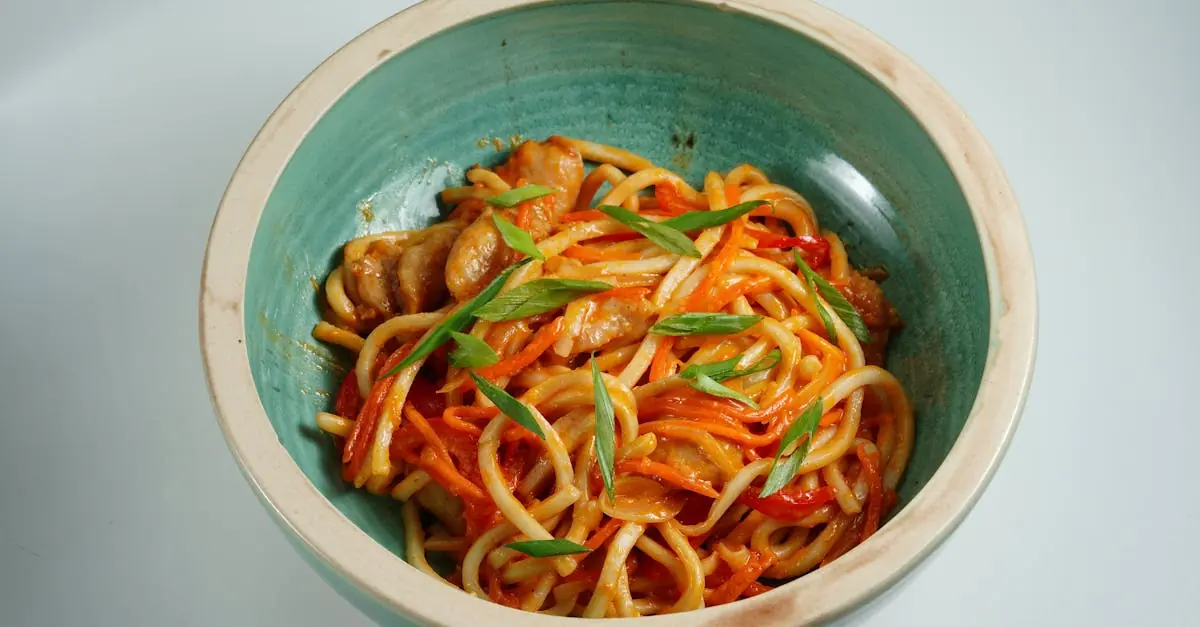Chicken tenderloins are the unsung heroes of the kitchen—lean, versatile, and ready to transform any meal from drab to fab. If you think healthy eating means sacrificing flavor, think again. These tender morsels can be dressed up in a variety of delicious ways, making them the perfect canvas for creativity.
Table of Contents
ToggleOverview of Chicken Tenderloin
Chicken tenderloins are small, thin strips of meat derived from the chicken breast. These cuts possess a mild flavor, making them ideal for various recipes. Their lower fat content compared to other cuts contributes to their reputation as a healthy option.
Cooking methods for tenderloins include grilling, baking, and sautéing. Each technique retains moisture and flavor without excessive calories. They also absorb spices and marinades well, enhancing their taste profile in dishes.
Nutrition highlights include approximately 25 grams of protein per 3-ounce serving. This protein-rich content supports muscle health and aids in weight management. Additionally, tenderloins contain essential vitamins such as B6 and niacin, both crucial for energy metabolism.
In terms of versatility, chicken tenderloins work well in salads, stir-fries, and wraps. Their quick cooking time allows for easy weeknight meals. Families often appreciate their simplicity, appealing to a range of palates.
For those seeking healthier options, chicken tenderloin recipes can include baked or grilled preparations rather than frying. Substituting heavy sauces for lighter versions, such as lemon or herb marinades, may further enhance health benefits.
Preparation tips suggest marinating tenderloins for at least 30 minutes to deepen flavors. Pairing tenderloins with colorful vegetables increases nutrient intake. Serve dishes over whole grains to create a balanced meal.
Chicken tenderloins serve as a nutritious and adaptable ingredient in the kitchen. Their health advantages align with modern dietary preferences, making them a popular choice for various recipes.
Health Benefits of Chicken Tenderloin
Chicken tenderloins offer several health benefits that make them an excellent choice for nutritious meals. Lower in fat than other chicken cuts, they provide a lean protein source that supports various dietary needs.
Nutritional Profile
Approximately 25 grams of protein exist in each 3-ounce serving of chicken tenderloin. Essential vitamins, including B6 and niacin, enhance energy metabolism and support the nervous system. The low fat content, typically around 3 grams per serving, helps maintain a balanced diet. High protein and low-calorie density make chicken tenderloins ideal for muscle health and weight management. Each tenderloin also contains minerals such as phosphorus and selenium, contributing to bone health and immune function.
Comparison with Other Cuts of Chicken
Compared to chicken thighs, tenderloins have significantly lower fat content, making them a healthier option. Skinless chicken breast offers similar nutritional values, yet tenderloins provide a more tender texture. Cooking times differ; tenderloins cook faster, which helps retain nutrients. Many recipes that suit chicken breast can also accommodate tenderloins, simplifying meal prep. By incorporating tenderloins, individuals maintain flavor without excess calories, positioning them as a practical alternative in meal planning.
Healthy Cooking Methods for Chicken Tenderloin
Chicken tenderloins lend themselves well to various healthy cooking techniques that enhance flavor without adding excess calories. Popular methods include grilling, baking, and sautéing, each preserving tenderness and nutrients.
Grilling
Grilling tenderloins brings out natural flavors while keeping them juicy. This method uses high heat, which seals in moisture and creates a delicious char. A marinade adds extra flavor; possibilities include olive oil, lemon juice, and herbs. Frequently turning the chicken ensures even cooking, achieving an internal temperature of 165°F. The result produces perfectly grilled tenderloins that pair well with fresh salads or whole grain sides.
Baking
Baking provides a simple way to prepare chicken tenderloins healthily. Utilizing an oven allows for even cooking at controlled temperatures. By placing tenderloins on a parchment-lined baking sheet, they roast beautifully without added fats. Seasoning with spices or a low-calorie marinade can enhance the dish. Cooking typically takes 20-25 minutes at 375°F, ensuring they retain moisture. Baked chicken tenderloins are versatile, suitable for meal prep, and perfect for adding to wraps or grain bowls.
Sautéing
Sautéing chicken tenderloins creates a quick, delicious meal option. This method requires minimal oil for cooking, preserving flavor while maintaining low calorie counts. Using a non-stick skillet helps reduce additional fat. Cutting tenderloins into smaller pieces allows for faster cooking, ideal for stir-fries with colorful vegetables. Cooking over medium-high heat for about 6-8 minutes achieves tenderness, creating a satisfying dish in less time. Sautéed chicken tenderloins work beautifully in various recipes, enhancing both taste and nutrition.
Delicious Chicken Tenderloin Recipes
Chicken tenderloins can shine in various delicious recipes. Here are a few healthy options to try.
Lemon Herb Grilled Chicken Tenderloins
Lemon herb grilled chicken tenderloins offer a bright, zesty flavor that elevates any meal. Marinate tenderloins in a mix of lemon juice, olive oil, garlic, and fresh herbs for at least 30 minutes. Grill the marinated chicken over medium heat until fully cooked, typically around 6-7 minutes per side. This method enhances the natural flavors, keeping calories in check. Serve these tenderloins alongside a fresh garden salad or whole grains for a well-rounded meal.
Healthy Chicken Tenderloin Stir-Fry
Healthy chicken tenderloin stir-fry combines quick cooking with colorful vegetables. Start by cutting tenderloins into bite-sized pieces for even cooking. Sauté the chicken in a small amount of oil until golden brown, about 4-5 minutes. Add bell peppers, broccoli, and snap peas next, cooking until just tender. Consider a splash of low-sodium soy sauce or teriyaki for extra flavor. This dish supports protein intake while showcasing the benefits of fresh veggies, making it an ideal weeknight dinner.
Baked Chicken Tenderloins with Vegetables
Baked chicken tenderloins with vegetables provide a wholesome dinner option that requires minimal effort. Place the tenderloins on a baking sheet with chopped carrots, zucchini, and bell peppers. Drizzle everything with olive oil and season with herbs and spices. Bake in an oven preheated to 400°F for around 20 minutes, or until the chicken is fully cooked. This method retains moisture and ensures the vegetables are perfectly tender. Enjoy this nutrient-dense meal as a fantastic accompaniment to quinoa or brown rice for extra fiber.
Tips for Choosing and Storing Chicken Tenderloin
Selecting chicken tenderloin requires attention to quality and freshness. Look for tenderloins with a pink hue and minimal marbling, indicating lean cuts. A quick check for any off smells ensures that the chicken is fresh. Packaging should be airtight, preventing leaks that can contaminate other foods.
When it comes to storage, refrigeration is key. Store chicken tenderloins in the coldest part of the refrigerator, ideally at a temperature below 40°F. If not used within two days, freezing extends their shelf life for up to six months. Properly sealing tenderloins in plastic wrap or a vacuum-sealed bag avoids freezer burn.
Thawing tenderloins safely is essential. Transfer them to the refrigerator for a gradual thaw, allowing even temperature distribution. Using a microwave for defrosting is an option, but cook immediately afterward to ensure even cooking.
For meal prep, consider portioning tenderloins into individual servings before freezing. This adds convenience during busy weekdays and helps maintain meal balance. Label each package with the date to keep track of storage duration. A reminder: cooked chicken can be refrigerated for up to four days, ensuring flexibility for leftovers.
By following these tips, chicken tenderloin maintains its freshness and quality, making meal preparation both easy and healthy. Enjoying the versatility of chicken tenderloin becomes simpler with proper selection and storage.
Chicken tenderloins offer a fantastic way to enjoy healthy meals without sacrificing taste. Their versatility allows for a wide range of delicious recipes that can fit any dietary preference. With their lean protein content and essential vitamins they contribute to overall health while supporting muscle maintenance.
By incorporating various cooking methods like grilling and baking individuals can create flavorful dishes that are quick and easy to prepare. With proper selection and storage techniques chicken tenderloins can remain fresh and ready for meal prep. Embracing these nutritious ingredients can lead to a healthier lifestyle filled with satisfying meals.




